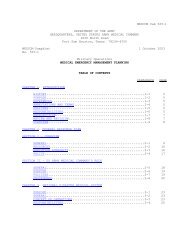(MCD) Guidelines
(MCD) Guidelines
(MCD) Guidelines
Create successful ePaper yourself
Turn your PDF publications into a flip-book with our unique Google optimized e-Paper software.
<strong>Guidelines</strong> for Military Mass Casualty Decontamination Operations<br />
During a Domestic HAZMAT/Weapon of Mass Destruction Incident<br />
damage. When such conditions exist and time does not permit prior approval from<br />
higher headquarters, local military Commanders and responsible officials of other<br />
DoD Components are authorized by DoD Directives, subject to any supplemental<br />
direction that may be provided by their DoD Component, to take necessary action to<br />
respond to requests of civil authorities. All such necessary action is referred to in this<br />
Directive as "Immediate Response." 19,20 Implementing this support must be<br />
consistent with the Posse Comitatus Act. 25<br />
Any Commander or official acting under the Immediate Response authority of DoD<br />
Directives shall advise the DoD Executive Agent through command channels, by the<br />
most expeditious means available, and shall seek approval or additional<br />
authorizations, as needed. 19<br />
4.0 Communication and Coordination with Civilian<br />
Incident Command<br />
INTENT: Establish communication with local Incident Command and determine<br />
situational needs and conditions.<br />
Effective response and recovery actions depend on<br />
effective communications among all participating people,<br />
agencies, and jurisdictions. NIMS are designed to assist<br />
in this communication using a standardized approach to<br />
incident management. Under NIMS, civilian response<br />
agencies use the Incident Command System to establish<br />
and maintain order and control of the scene. 8,26<br />
The Command and General Staff positions, shown in<br />
Figure 1, implement the Incident Command System<br />
principle of unity of command. Command Staff positions<br />
are shown in black and General Staff positions are shown<br />
in white. Only the Incident Commander position is<br />
required for each response. The other positions are filled<br />
depending on the nature and severity of the incident.<br />
Figure 1: Incident Command System Showing Unity of<br />
Command.<br />
Public Information Officer<br />
Liaison Officer<br />
Incident Commander<br />
Safety Officer<br />
Operations Section Planning Logistics Finance/Administration<br />
Branch<br />
Divisions<br />
Groups<br />
Strike Team<br />
Task Force<br />
Single Resource<br />
Resources<br />
Situation Unit<br />
Documentation Unit<br />
Demobilization<br />
Support Branch<br />
Supply Unit<br />
Facilities Unit<br />
Ground Support Unit<br />
Service Branch<br />
Communications Unit<br />
Medical Unit<br />
Food Unit<br />
Time Unit<br />
Procurement Unit<br />
Compensation Claims Unit<br />
Cost Unit<br />
<strong>MCD</strong> Principles for<br />
Civilian Contact and<br />
Coordination<br />
DHS UTL Tasks<br />
• ResA1a 3.1<br />
• ResB1a 3.2.1 and 3.3.3<br />
• ResB2b 3.2.3 and<br />
3.2.6.1<br />
• Res.B2b 3.2.5.4<br />
USACBRNS Tasks<br />
• 03-1-6592 Steps 1, 2, 3,<br />
9, 10, 11 12<br />
• 03-2-6594 Steps 1a, 1f,<br />
2c, 3a, 4a, 6, 7, 8<br />
• 03-3-5130 Steps 1, 2, 3,<br />
11g, and 12<br />
6 Original



